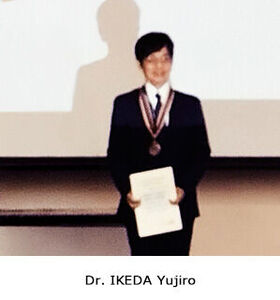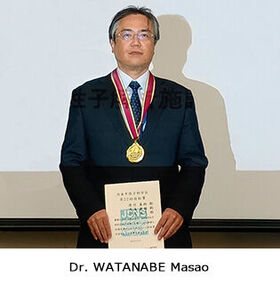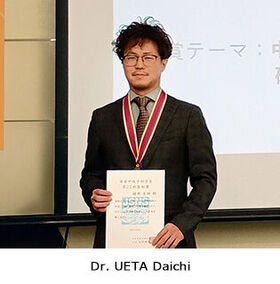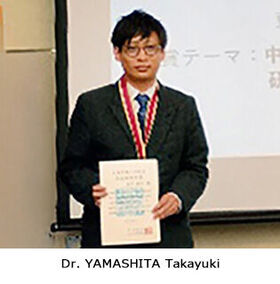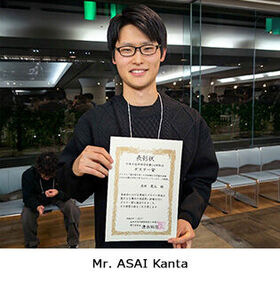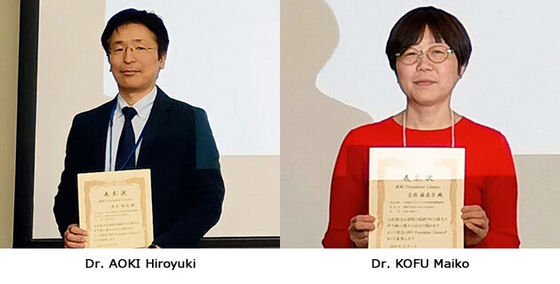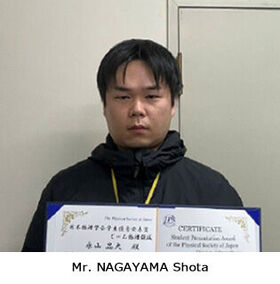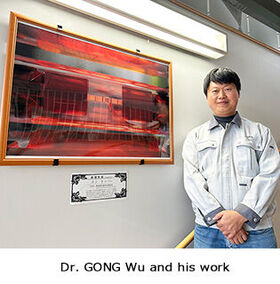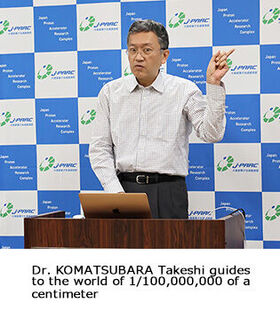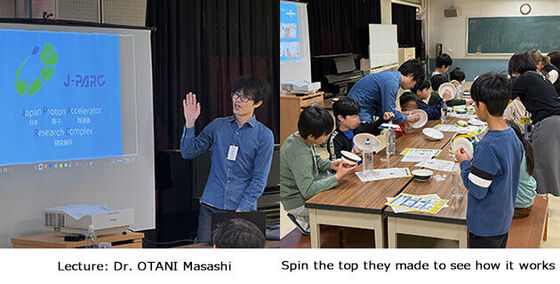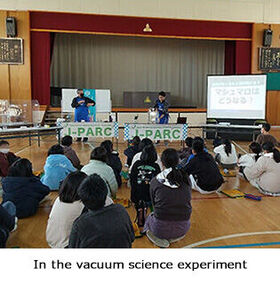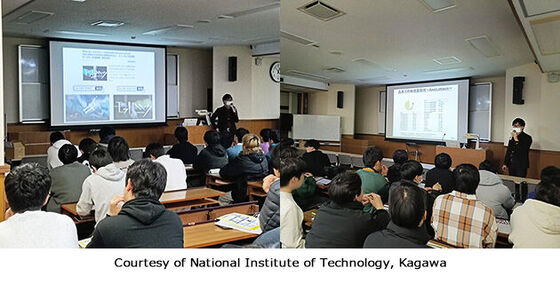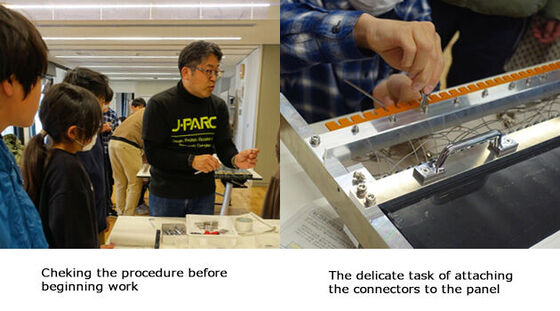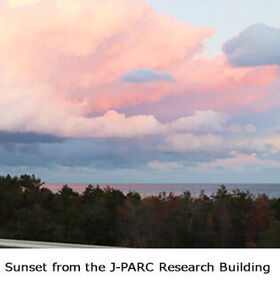J-PARC News January 2025 (Issue #237)
■Award Winners
① Achievement Award
This award is given to individuals who have made outstanding contributions to the development of neutron science in Japan. The award was presented to Dr. IKEDA Yujiro, the former director of the J-PARC Center and currently a senior visiting scientist at the RIKEN Center for Advanced Photonics. Dr. IKEDA, who has been involved with J-PARC since its construction phase, passionately gave an award lecture on challenging events which he had worked with many people together for J-PARC.
② Technology Award
This award is given to those who have made outstanding contributions to the technical development of neutron science. Dr. WATANABE Masao of the Technology Development Section received the award.
Dr. WATANABE and his colleagues have developed and matured the pulsed high-field magnet equipment from its initial development to a stage available to J-PARC users, in order to realize neutron diffraction experiments under high magnetic fields, which had been a longstanding problem in the neutron field, and from there have made numerous technological innovations that have spread to other neutron facilities around the world.
③ Encouragement Award
i ) Dr. UETA Daichi of the Neutron Science Section received the award.
Dr. UETA conducted neutron experiments on cerium, which exhibits a wide variety of physical properties, focusing on its magnetic properties. He observed magnetic properties, magnetic anisotropy and magnetic excitations in cerium-containing compounds, and clarified the reasons for the appearance of unique physical properties. These achievements are expected to play an important role in the new understanding of 4f electron systems containing cerium, which cannot be explained by conventional theories. He delivered the award lecture entitled ‘Study of novel physical properties in Ce compounds’.
ii) Dr. YAMASHITA Takayuki, a former postdoctoral researcher in the Neutron Science Section and now an assistant professor at Osaka University, received the award.
Using TAKUMI, the engineering materials diffractometer at J-PARC, Dr. YAMASHITA studied the mechanism of high strength and excellent ductility of advanced structural materials expected to be used in a wide range of next-generation industries. He gave an award lecture on ‘Appearance Mechanism of the Mechanical Properties in Advanced Structural Materials via Pulsed In-situ Neutron Diffraction’.
The award is given to young researchers under the age of 40 who have published outstanding research in neutron science.
④ Poster Award
Mr. ASAI Kanta, M1(First-year master’s student), Particle Property Laboratory, Graduate School of Science, Nagoya University, a special research student of 3He Spin Filter Group, Japan Atomic Energy Agency, received the award.
The title of the presentation was "Development of 3He spin filters for epi-thermal neutrons for experiments using compound nuclei to search for unknown interactions".
⑤ “Hamon” President Choice
This is awarded every two years for selected papers published in the academic journal “Hamon” of the Japan Society of Neutron Science. The winners this time were Dr. AOKI Hiroyuki of the Neutron Science Section for his paper “Structural Analysis of Adhesive Interfaces Using Neutron Reflectometry” and Dr. KOFU Maiko, formerly of the same section, for her paper “Local Magnetic Excitations in Classical Spin Glasses.”
Their papers were published in “Hamon,” Vol. 33 (2023), No. 4 and Vol. 34 (2024), No. 3, respectively.
■The Physical Society of Japan (Sapporo Campus, Hokkaido University; September 16th – 19th)
In the 79th annual meeting of the Physical Society of Japan, Mr. NAGAYAMA Shota, a special research student of J-PARC Accelerator Section III received the Student Excellent Presentation Award for his presentation on "Development of a Non-destructive Electrostatic Septum for Slow Extraction in a High-Intensity Proton Accelerator".
He is currently developing a non-destructive electrostatic septum that reduces beam loss by changing the beam density with an optimized electric field, which is different from the current structure, and he has shown through simulation that this method is effective for the beam loss reduction. This technology is expected to improve the maintainability and further increase the intensity of the J-PARC Main Ring (MR).
■Winner of the Science Prize in the 7th Science Photo Contest
The Science Prize was awarded to Dr. GONG Wu of the Neutron Science Section for his work titled "Magnesium alloy undergoing high temperature deformation" in the general category in this contest sponsored by the Organization on Science and Technology and co-sponsored by the Ministry of Education, Culture, Sports, Science and Technology.
This work also won the Grand Prize in the J-PARC Photo Contest 2024.
■Discovery of altermagnetic material (the third type of magnets) capable of reading and writing information at room temperature.
-For the next generation of ultra-high-density and ultra-high-speed information media (December 13th)
Using X-ray and neutron diffraction experiments, we have discovered for the first time in the world that the magnetic semiconductor FeS (iron sulfide) is an altermagnetic material that can read and write information at room temperature. Unlike ferromagnetic materials that have been used in the past, altermagnetic materials have the following characteristics: (1) they are advantageous for the integration of devices because there is no leakage magnetic field that causes interference between bits, (2) their response speed is more than 100 times faster, and (3) they are highly resistant to magnetic disturbances and are expected to be used as next-generation, ultra-high-density and ultra-high-speed information media.
■Hello Science
“The world is made up of particles ~ an introduction to J-PARC~” (December 20th )
Dr. KOMATSUBARA Takeshi, Deputy Director of J-PARC, introduced the mechanisms and principles of J-PARC incorporating the contents of the special exhibition held this summer at the Tokai Village Museum.
He explained the physical laws on which the J-PARC apparatuses are based on, how the accelerators can bend the direction of the moving protons, and the units and numerical values often heard at J-PARC, such as megawatts for beam power and their order of magnitude.
This world is made up of very, very small “particles” that we cannot see with the eyes. We aim at the cutting edge research at J-PARC to discover the nature of “particles” that many of our predecessors have been considering for thousands of years and to unravel the origins of elementary particles, fundamental physics and matter. We hope that this “Hello Science” event had been a good opportunity to learn more about J-PARC.
■J-PARC Outreach Activities
(1) KIPP Nakameguro Children’s Class at Nakameguro Elementary School (December 14th)
A lecture titled “The world’s smallest? Let’s touch the world of elementary particles by making a mysterious top” was held at the Nakameguro Children’s Class in Nakameguro Elementary School. Dr. OTANI Masashi, Accelerator Ⅶ Section, gave a lecture on top spinning for 13 students from 1st to 5th grade.
After an introduction to J-PARC and an explanation of elementary particles, the children spun the gyroscope and observed the change in direction of precession by spinning a top or changing the center of gravity of a top they made. They learned that precession is similar to the spin nature of elementary particles.
(2) Nakamachi Elementary School, Hitachi City (December 18th)
Dr. KAMIYA Junichiro, Accelerator Division, and Dr. UZUMAKI Tatsuya, JAEA Media Relations Section, conducted a science experiment class on “Vacuum” for 5th and 6th graders at Nakamachi Elementary School. This was in cooperation with outreach activities conducted by the Hitachi Civic Center for elementary schools in the city. The children enjoyed and deepened their understanding of the forces of vacuum and atmospheric pressure through questions such as “What happens to balloons and marshmallows in a vacuum desiccator?” “Can sound be transmitted in vacuum?” and “What happens to hot water and soda water in vacuum?”
The lecture also introduced the fact that a vacuum equivalent to the height of a satellite ( about 40,000 km above the Earth) is created inside the J-PARC accelerator.
Finally, the children were surprised and cheered when pin-pong balls and cans exploded with a loud noise in the “vacuum cannon” experiment, which allowed them to experience the ultra-powerful force of the air (atmospheric pressure).
■Takamatsu Campus, National Institute of Technology, Kagawa College (January 6th)
At Takamatsu Campus in National Institute of Technology, Kagawa College (hereinafter referred to as the College), Dr. OTANI Masashi of the Accelerator Division gave a lecture titled "The Mechanism of Accelerators that Reveal the Microscopic World: Muon Acceleration Technology that Reveals Everything from Elementary Particle Phenomena to Giant Structures" to about 100 fourth-year students.
In his lecture, he first explained the principles of accelerators and then introduced examples of accelerator applications, including medical applications. Next, he discussed elementary particle muons, which are used to discover the secret rooms of ancient pyramids and to see through inside volcanoes, and explained the latest technological developments and research being carried out using the large quantities of artificially produced muons at J-PARC. At the beginning of the lecture, he also introduced the songs "Atokata" and "Motto Hayaku" by the creative label Academimic, which aims to fuse the research that he supervises with pop culture. At the end of the lecture, he also touched on the efforts being made at the College to build accelerators, and explained how the expertise and skills learned at the College contribute to the development of useful devices for society, including accelerators, based on his own experience as a graduate of National Institute of Technology. In the post-lecture questionnaire, comments such as "I wanted to hear more about the relationship between space and accelerators" were received, and it was clear that the audience was interested in the content of research using accelerators.
■Building the second detector, Muographic Investigation of Ancient Burial Mounds in Tokai (January 19th, Tokai Village Museum)
The first activity of “Muographic Investigation of Ancient Burial Mounds in Tokai” this year was held at the Tokai Village Museum on January 19th. The construction of the second muon detector began in November last year, and the theme of this third construction session was “Let’s assemble the frame of the scintillator plate and attach the connectors.” The 18 participants were divided into three groups, and under the guidance of J-PARC researchers and Ibaraki University faculty and students, they took up the challenge of this very delicate and concentrated work. The delicate work will continue with the aim of completing the detector in March.
■J-PARC Sanpomichi 54 “Sunset” in the East 
Thank you very much for reading J-PARC NEWS every time.
In this month's issue, we would like to share with you a photo taken from the fourth floor of the J-PARC research building, which some of you may have thought was the first sunrise of the year since we published a photo of red clouds and the sea in the January issue. However, it was actually taken in the evening, looking east.
Just at this time , there were clouds to the east and west, and the clouds in the east were higher than those in the west. The setting sun hitting the clouds in the west reflected off the clouds in the east, emitting red light, which then fell onto the ocean surface.
The secondary particles produced at J-PARC also show complex behavior like this sunset. We will continue to explore the nature of matter by using the more powerful beam output at J-PARC to study deeply the behavior of secondary particles. We look forward to your continued support this year.

